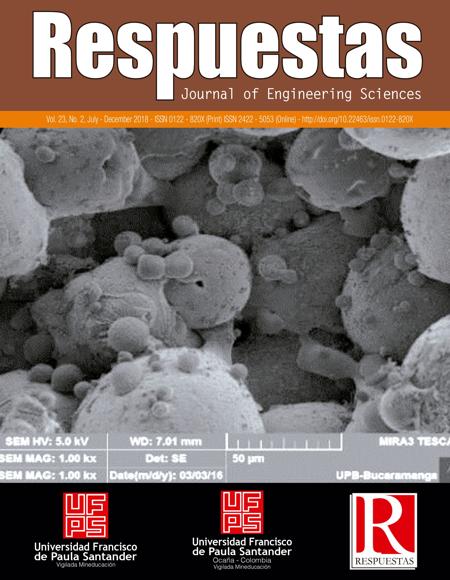Correlation between handgrip strength and hand-forearm anthropometry
Correlation between handgrip strength and hand-forearm anthropometry
Contenido principal del artículo
The Pearson correlation coeffi cient (r) between the grip strength and hand-forearm anthropometry was found to determine either existing or not a linear relation among them. Collecting data of the variables was obtained from ten young adults in both, right and left hand-forearm, it was taken into account some qualitative variables: to be right-handed, the gender with five (5) men and five (5) women, and it was established as a condition that the individual was healthy and did not have a previous career as an athlete. A direct linear relationship with hand anthropometry and the grip strength is concluded, even though as expected, there was a strong difference between the force exerted by a male and a female individual, being the first stronger. Respect to the forearm, an inverse relation was found between the maximum circumference of the forearm and the grip strength. Finally, the strongest relationships found were in the width and length of the palm, as well as in the circumference of the wrist. Results were validated comparing the results of this research against the results of specialized literature. Some considerations may be considered for future research. Grip strength can promote the risk of accidents and ergonomists should consider this factor appropriately for their design.
Descargas
Datos de publicación
Perfil evaluadores/as N/D
Declaraciones de autoría
Indexado en
- Sociedad académica
- Universidad Francisco de Paula Santander
- Editorial
- Universidad Francisco de Paula Santander
Detalles del artículo
R.M. White. “Comparative Anthropometry of the Hand”, Army Natick Research and Development Laboratories, 1981.
J. Rodríguez, F. Maradei y J. Martínez, “Improvement of a cutting flowers tool by using ergonomic design”, Revista UIS Ingenierías, vol. 18, no. 2, pp. 161–166, 2019.
S. Daniels-Gilbert and H.T.E. Hertzberg, “Applied Anthropometry of the Hand”, American Journal of Physical Anthropology, vol. 10, no. 2, pp. 209-216, 1952.
T. Kanchan and K. Krishan, “Anthropometry of hand in sex determination of dismembered remains - A review of literature,” Journal of Forensic and Legal Medicine, vol.18, no. 1, pp. 14–17, 2011.
D. Leyk et al., “Hand-Grip Strength of Young Men, Women and Highly Trained Female Athletes”, European Journal of Applied Physiology, vol. 99, no. 4, pp. 415– 21, 2007.
C.W. Nicolay and A.L. Walker, “Grip strength and endurance: Influences of anthropometric variation, hand dominance, and gender,” International Journal of Industrial Ergonomics, vol. 35, no. 7, pp. 605–618, 2005.
J. Sallinen, S. Stenholm, T. Rantanen, M. Heliövaara, P. Sainio and S. Koskinen, “Hand grip strength cut points to screen older persons at risk for mobility limitation,” Journal of the American Geriatrics Society, vol. 58, no. 9, pp. 1721–1726, 2010.
H.C. Roberts et al., “A review of the measurement of grip strength in clinical and epidemiological studies: Towards a standardised approach,” Age Ageing, vol. 40, no. 4, pp.423–429, 2011.
A.W. Castellanos-Morantes y L.E. Méndez-Serrano, “Estudio de la Relación entre la Antropometría de la Mano y la Distribución de Fuerzas en el Agarre Máximo en Individuos no Atletas”, trabajo de fin de grado, Universidad Industrial de Santander, Bucaramanga, 2017.
V. Mathiowetz, K. Weber, G. Volland and N. Kashman, “Reliability and validity of grip and pinch strength evaluations”, The Journal of Hand Surgery, vol. 9, no. 2, pp. 222–226, 1984.
P. Bruce and A. Bruce, Practical statistics for data scientists: 50 essential concepts Beijing: OReilly, 2017.
P. Karl and G. Francis, “VII. Note on regression and inheritance in the case of two parents,” Proceedings of the Royal Society of London, vol. 58, no. 347–352, pp. 240–242, 1895.
J.W. Garrett, “The Adult Human Hand: Some Anthropometric and Biomechanical Considerations,” Human Factors, vol. 13, no. 2, pp. 117–131, 1971.
S. Giampaoli et al., “Hand-grip strength predicts incident disability in non-disabled older men.,” Age Ageing, vol. 28, no. 3, pp. 283–288, May 1999.
Panero and M. Zelnik, Human Dimension and Interior Space. New York: Random House US, 2014.
Coordinación de promoción y prevención, “Protocolo De Evaluación De Medidas Antropométricas,”, Colombiana de Salud, 2014.
Instituto Nacional de Salud, “Medidas antropométricas, registro y estandarización,” 1998.
Universidad de los Andes, “Protocolo para la toma y registro de medidas antropométricas” Nieer, 2009.
T. G. Lohmann, A. F. Roche, and R. Martorell, Anthropometric Standardization Reference Manual. Human Kinetics Books, Champaign, III., 1988.
D.A. Kallman, C.C. Plato and J.D. Tobin, “The Role of Muscle Loss in the Age-Related Decline of Grip Strength: Cross-sectional and Longitudinal Perspectives”, Journal of Gerontology, vol. 45, no. 3, pp. 82–88, 1990.
V. Mathiowetz, C. Rennells and L. Donahoe, “Effect of elbow position on grip and key pinch strength”, The Journal of Hand Surgery, vol. 10, no. 5, pp. 694–697, 1985.








